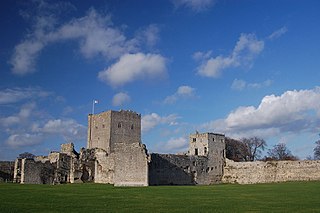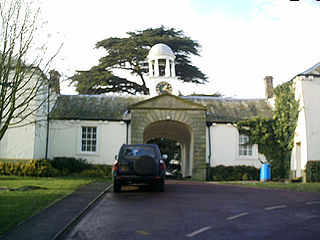
Ogle Castle (grid reference NZ14057908 ) is a former fortified manor house at Ogle, near Whalton, Northumberland. It is a Scheduled Ancient Monument and a Grade I listed building. [1]

Ogle Castle (grid reference NZ14057908 ) is a former fortified manor house at Ogle, near Whalton, Northumberland. It is a Scheduled Ancient Monument and a Grade I listed building. [1]
After the Norman Conquest in 1066, Humphrey de Hoggell was granted rights over the manor of Ogle. [2] Northumberland was then a border county and in 1341, Sir Robert Ogle was allowed a licence to crenellate or fortify the manor; in 1346, David II of Scotland was held prisoner here after his capture at the Battle of Neville's Cross. [3]

The last direct descendant in the senior line, Catherine Ogle (c. 1568–1629), married Sir Charles Cavendish and after her death, the manor passed to their son, William Cavendish, later 1st Duke of Newcastle. Cavendish was the senior Royalist in the North during the 1642–1646 First English Civil War and spent much of his fortune raising troops for Charles I; after defeat at Marston Moor in 1644, he went into exile in Europe, returning only after the 1660 Restoration. [4]
Parliament sold Ogle Castle in 1653 to James Moseley, who repaired some of the damage done during the civil wars but the original house was extensively rebuilt after it was returned to William in 1660. [5] The modern building largely dates from that period, retaining only the mediaeval tower house and its projecting latrine, as well as showing parts of a double moat on the western and northern sides. [1]
In the early 19th century, an East Indiaman named Ogle Castle was wrecked on the Goodwin Sands on 3 November 1825, with the loss of over 100 crew members and passengers. [6] [7]
Duke of Newcastle upon Tyne was a title that was created three times, once in the Peerage of England and twice in the Peerage of Great Britain. The first grant of the title was made in 1665 to William Cavendish, 1st Marquess of Newcastle upon Tyne. He was a prominent Royalist commander during the Civil War.

Edlingham Castle is a small castle ruin, having scheduled monument and Grade I listed building status, in the care of English Heritage. It is located in a valley to the west of Alnwick, Northumberland, England. It has been described as "...one of the most interesting in the county", by Nikolaus Pevsner, the architectural historian. Edlingham itself is little more than a hamlet with a church alongside the castle.

William Cavendish, 1st Duke of Newcastle upon Tyne, KG, KB, PC was an English courtier and supporter of the arts. He was a renowned horse breeder, as well as being patron of the playwright Ben Jonson, and the intellectual group known as the Welbeck Circle.
Tynemouth Castle is located on a rocky headland, overlooking Tynemouth Pier. The moated castle-towers, gatehouse and keep are combined with the ruins of the Benedictine priory where early kings of Northumbria were buried. The coat of arms of the town of Tynemouth still includes three crowns commemorating the tradition that the Priory had been the burial place for three kings.
Baron Ogle is an abeyant title in the Peerage of England. It was created in 1461 for Robert Ogle. It fell into abeyance in 1691. The Ogles were a prominent Northumbrian family from before the time of the Norman Conquest. They settled at Ogle, Northumberland and in 1341 were granted a licence to fortify their manor house which became known as Ogle Castle. The family included seven Medieval Barons. Their estates fell by marriage to the Cavendish family following the death of the 7th Baron in 1597.

Bolton is a small village and former civil parish, now in the parish of Hedgeley, in the county of Northumberland, England. It is situated on the north side of the River Aln, about two miles (3 km) east by north from Whittingham, and 5+1⁄2 miles west from Alnwick. It has a chapel and a small number of residential properties.

Henry Cavendish, 2nd Duke of Newcastle-upon-Tyne, KG, PC, styled Lord Cavendish until 1676, and Viscount Mansfield from 1676, was an English politician who sat in the House of Commons from 1660 to 1676, and then inherited the dukedom.
This is a list of the High Sheriffs of the English county of Northumberland. The High Sheriff is the oldest secular office under the Crown. Formerly the High Sheriff was the principal law enforcement officer in the county but over the centuries most of the responsibilities associated with the post have been transferred elsewhere or are now defunct, so that its functions are now largely ceremonial. The High Sheriff changes every March.

Sir Thomas Grey, of Heaton Castle in the parish of Norham, Northumberland, was one of the three conspirators in the failed Southampton Plot against King Henry V in 1415, for which he was executed.

Delaval is the surname of a family of gentry/aristocracy in Northumberland, England, from the 11th century to the 19th century. Their main estate was the manor of Seaton Delaval. The 18th century Delavals are noteworthy for their colourful lifestyle, for the magnificent Seaton Delaval Hall and for the development of the little seaport of Seaton Sluice and a coal mine at Old Hartley.

Ogle is a village in and former civil parish, now in the parish of Whalton, Northumberland, England, north-west of Ponteland and south-west of Morpeth. The surname Ogle comes from here, where the Ogle family built Ogle Castle and owned Kirkley Hall. In 1951 the parish had a population of 122.

Bothal Castle is a castle and stately home in the village of the same name near the River Wansbeck, between Morpeth and Ashington in the English county of Northumberland. Botl is Old English for a dwelling. Bothal could refer to a particular dwelling or hall. It was fortified before the Norman conquest, and renovated and remodelled a number of times. It is a Scheduled Ancient Monument and a Grade I listed building.

The Ogle baronetcy, of Worthy, was a title in the Baronetage of the United Kingdom. It was created on 12 March 1816 for Admiral Chaloner Ogle, of Kings Worthy, Hampshire. The Ogles were a prominent Northumberland family from before the time of the Norman Conquest. They settled at Ogle, Northumberland, and in 1341 were granted licence to fortify their manor house, which became known as Ogle Castle. In the 14th and 15th centuries the family included seven medieval Barons. Their estates, including Ogle and Bothal Castle, fell by marriage to the Cavendish family on the death of the 7th and last Baron, without male heir in 1597.
The Selby family is a prominent and prolific family in the English gentry that originated in Selby, Yorkshire, but largely settled in Northumberland and County Durham. At various points through history, the family owned Biddlestone Hall and Twizell Castle in Northumberland in addition to the manor houses Ightham Mote in Kent and at Beal, Northumberland. The family had two baronetcies; the Selby and the Selby-Bigge but both are now extinct.
The Ogle family were prominent landed gentry in Northumberland, England. The earliest appearances of the family name were written Hoggel, Oggehill, Ogille and Oghill.
Sir Peter Killigrew, 2nd Baronet of Arwenack, St Budock, Cornwall was an English politician who sat in the House of Commons in 1660.
Captain Sir Thomas Liddell, 1st Baronet (1578–1652) was an English politician, a member of the Liddell family which monopolized the local government of the North of England during the 16th and 17th centuries. He was one of the leading supporters of the Royalist cause in the English Civil War.
Otterburn Tower is a Grade II listed castellated, three star country house hotel in Otterburn, Northumberland. It is set in 32 acres (13 ha) of deer park and woodland in the Northumberland National Park in northeastern England. Founded by a cousin of William the Conqueror in 1086, it was later owned by the Clan Hall, before being rebuilt in 1830 by Thomas James, a magistrate, on the site and using some of the stones from the Otterburn Castle. Nearby Otterburn Hall was built in 1870 on land given to a Lord Douglas as recompense for the death of his ancestor Lord William Douglas in the Battle of Otterburn.

The Lilburns are a family originating in Northumberland, United Kingdom, and were members of the country's lesser gentry throughout the Late Middle Ages up until the 17th Century. The family name Lilburn derives from the original home of the family, Lilburn, Northumberland.

Sir Robert de Ogle was an English soldier and feudal landowner in Northumbria who fought in the border conflicts with Scotland. He captured five Scottish knights near Newcastle in 1341 and was licensed to crenellate Ogle House. He distinguished himself in resisting the foray into Cumberland of Sir William Douglas in 1345, fought at Neville's Cross in 1346 and took three nobles prisoner, and held Berwick Castle against the Scots in 1355.